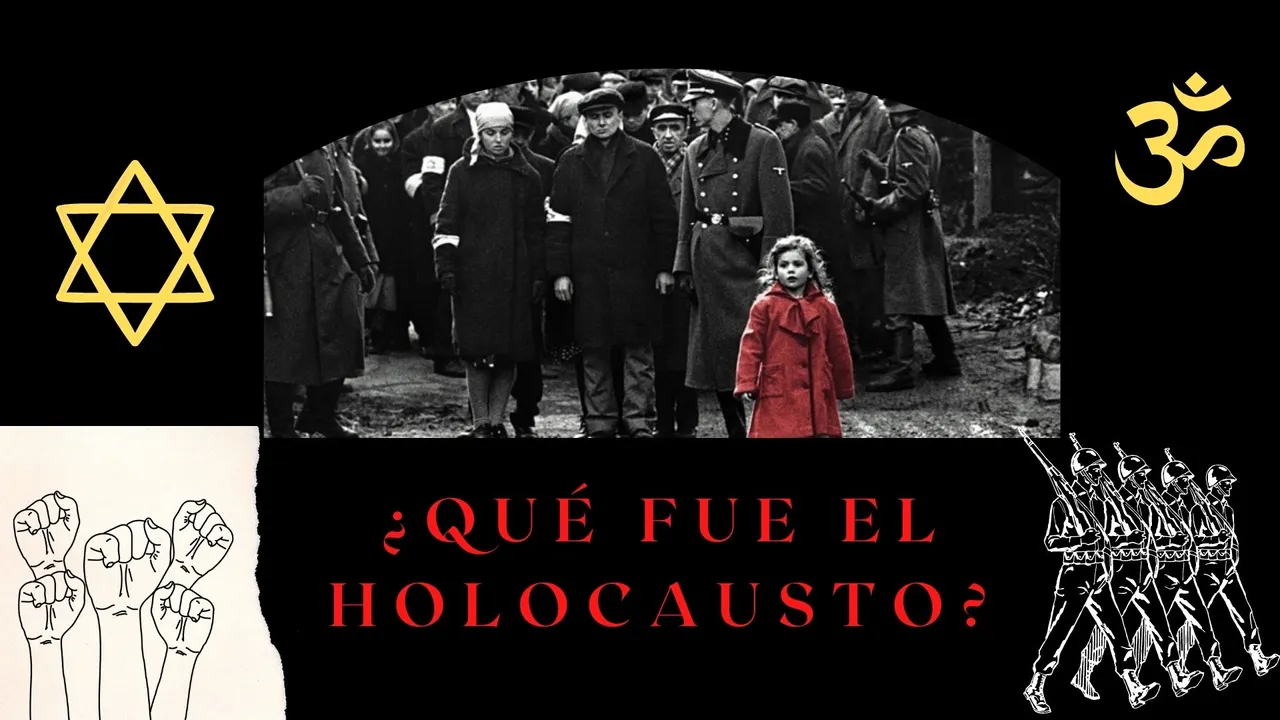
¡Hola, amigos Hiver! No sé si alguna vez se habrán preguntado como se inició toda esa campaña antisemita que surgió en Europa, especialmente en los años cuarenta, durante la segunda guerra mundial, y cobró la vida de más de seis millones de judíos, pero en este artículo, les voy a hablar especialmente de eso, como se inició todo, y de qué forma.
Hello, Hiver friends! I don't know if you have ever wondered how all that anti-Semitic campaign that arose in Europe, especially in the 1940s, during the Second World War, began and took the lives of more than six million Jews, but in this article, I'm going to talk especially about that, how it all started, and in what way.

¿Qué significa la palabra «Holocausto»?
What does the word "Holocaust" mean?
Esta palabra se refiere al exterminio masivo de personas con el objetivo de eliminar un grupo étnico a causa de su religión, raza o preferencia política. No obstante, este término era utilizado antiguamente por los judíos para referirse al sacrificio de un animal que posteriormente ofrendarían a Dios. Después de sacrificado, el animal era incinerado.
This word refers to the mass extermination of people with the aim of eliminating an ethnic group because of their religion, race or political preference. However, this term was used in ancient times by the Jews to refer to the sacrifice of an animal that they would later offer to God. After slaughter, the animal was cremated.
Resulta irónico y hasta espeluznante comprender que era exactamente lo que terminó sucediendo con muchos de esos judíos, luego de salir de las cámaras de gases en los campos de exterminio a los que fueron enviados.
It's ironic and even shocking to understand that this was exactly what ended up happening to many of these Jews, after they emerged from the gas chambers in the death camps to which they were sent.
Cuando hablamos del Holcausto ocurrido durante la segunda guerra mundial, nos referimos al genocidio más grande en la historia de la humanidad, ya que los nazis exterminaron a las tres cuartas partes de los judíos europeos.
When we talk about of the Holcaust that occurred during the Second World War, we are referring to the largest genocide in human history, as the Nazis exterminated three-quarters of European Jews.
¿Cómo inició todo este odio?
Los judíos en Europa no solo se habían multiplicado, sino que además habían hecho crecer sus ganancias. Debido al esfuerzo de su duro trabajo y a su productividad, se hicieron muy populares y comenzaban a ser conocidos como sinónimo de progreso. Esto era algo que resultaba inconcebible para la mentalidad antisemita de muchos supremacistas como Hittler, que cuando llegó al poder de Alemania, mediante la ley habilitante el 23 de marzo de 1933, no dudó en llevar a cabo sus planes de deshacerse de ellos mediante un plan cuidadosamente orquestado por él y su equipo.
The Jews in Europe had not only multiplied, but also increased their profits. Due to the effort of their hard work and their productivity, they became very popular and began to be known as a synonym for progress. This was something that was inconceivable to the anti-Semitic mentality of many supremacists like Hittler, who when he came to power in Germany, through the enabling law on March 23, 1933, he didn't hesitate to carry out his plans to get rid of them by means of a plan. carefully orchestrated by him and his team.
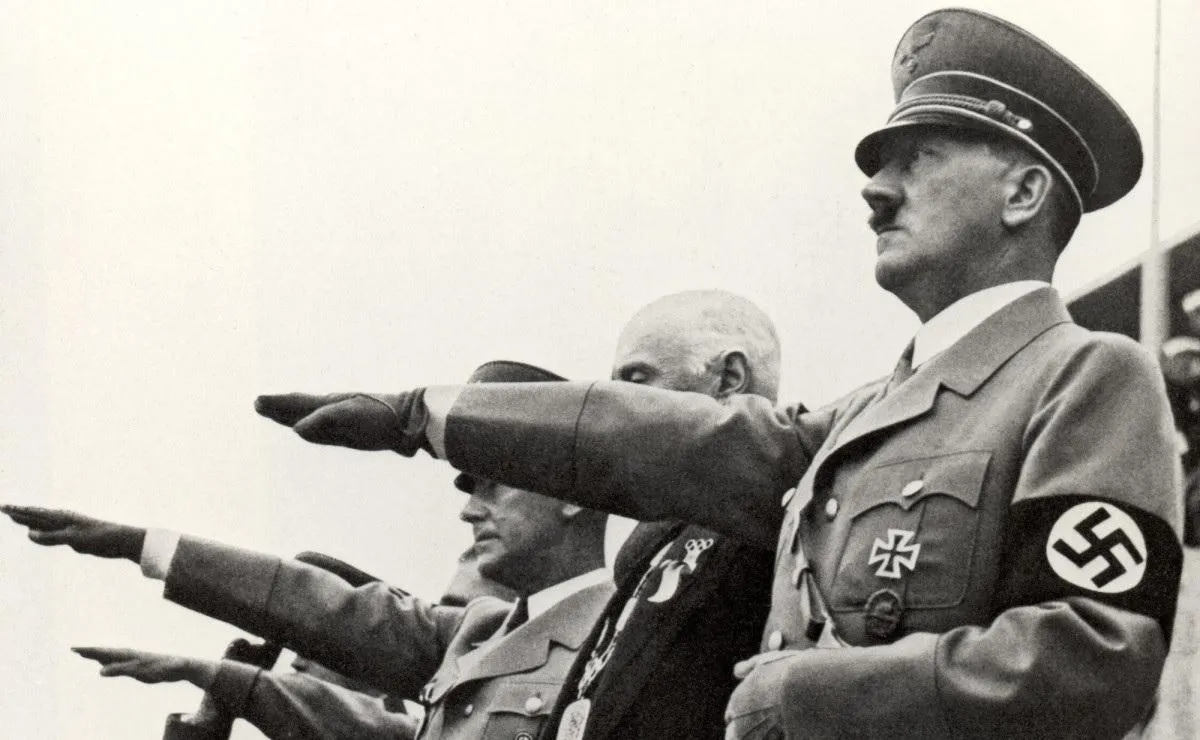
Después de la primera guerra mundial, hubo una gran depresión económica durante los años 20, no obstante, muchos judíos se las habían arreglado para mantener más o menos estables sus ganancias, debido quizá a buenas inversiones o a sus ahorros, pero los nazis se encargaron de hacer crecer el mito de que los judíos eran gente usurera, malvada y especuladora, y que por tanto eran los responsables de todo: del declive financiero y hasta del hecho de que Alemania perdiera la primera guerra.
After the First World War, there was a great economic depression during the 1920s, however, many Jews had managed to keep their earnings more or less stable, perhaps due to good investments or their savings, but the Nazis began to grow the myth that the Jews were usurious, evil and speculative people and that they were therefore responsible for everything: the financial decline and even the fact that Germany lost the first war.
En las escuelas, los profesores comenzaron a adoctrinar a los niños, enseñándoles a diferenciar a los judíos de los demás, mostrándoles dibujos que exageraban sus rasgos para estereotiparlos, y siempre recalcando que eran personas de las que deberían cuidarse.
In schools, teachers began to indoctrinate children, teaching them to differentiate Jews from others, showing them pictures that exaggerated their features to stereotype them, and always emphasizing that they were people to watch out for.
Aquí podemos ver, por ejemplo, la ilustración de un libro para niños, publicado en 1935 en Nurenberg, Alemania. El libro se llama «Der Giftpilz» que significa «El hongo venenoso» En el título de la ilustración dice «La nariz prominente, parece un número seis»
Here we can see, for example, the illustration of a children's book, published in 1935 in Nurenberg, Germany. The book is called «Der Giftpilz» which means «The poisonous mushroom». The title of the illustration says «The prominent nose, it looks like a number six»
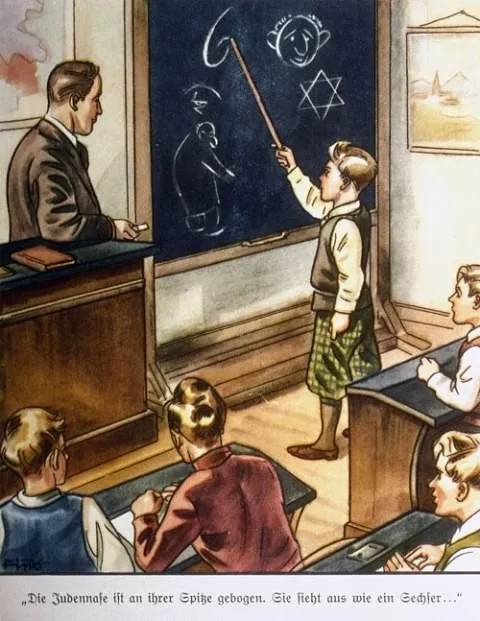
Incluso se les leía cuentos donde los villanos siempre eran los judíos, representados como rabinos vestidos de negro, con sombreros de copa alta, narices prominentes y largas barbas, que intentaban atraer a las personas (siempre representadas con la raza aria) para robarles su dinero o lasimarlos. «Debían cuidarse de su naturaleza malvada» «Eran una raza inferior, pero de mucho cuidado»
They were even read stories where the villains were always the Jews, represented as rabbis dressed in black, with high top hats, prominent noses and long beards, who tried to lure people (always represented with the Aryan race) to steal their money. or lasimar them. "They had to beware of their evil nature" "They were an inferior race but you had to fear them"
Esta ilustración pertenece a un manual antisemita para niños, publicado en 1936, el cartel dice: «Los judíos no son bienvenidos aquí»
This illustration is from an anti-Semitic manual for children, published in 1936, the sign reads: "Jews are not welcome here."
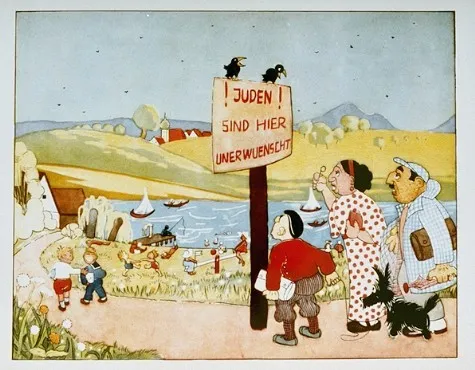
Un extracto de este libro dice: «Eres judío, gritó Hans, sosteniendo la mano de su hermana, corriendo tan rápido como sus pies lo llevaron»
An excerpt from this book reads: "You are a Jew, cried Hans, holding his sister's hand, running as fast as her feet carried him."
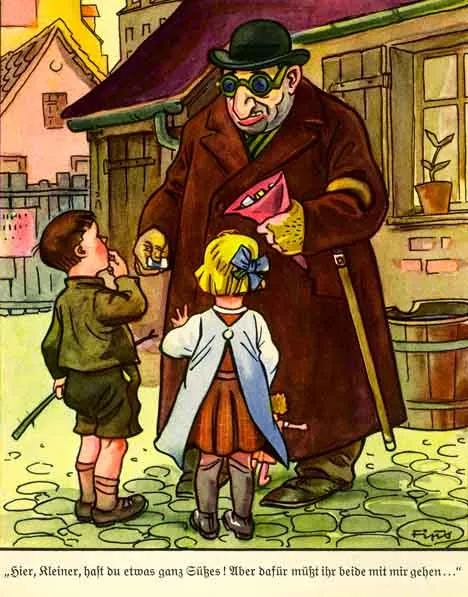
«El judío celoso del robusto alemán»
"The Jew Jealous of the Robust German"
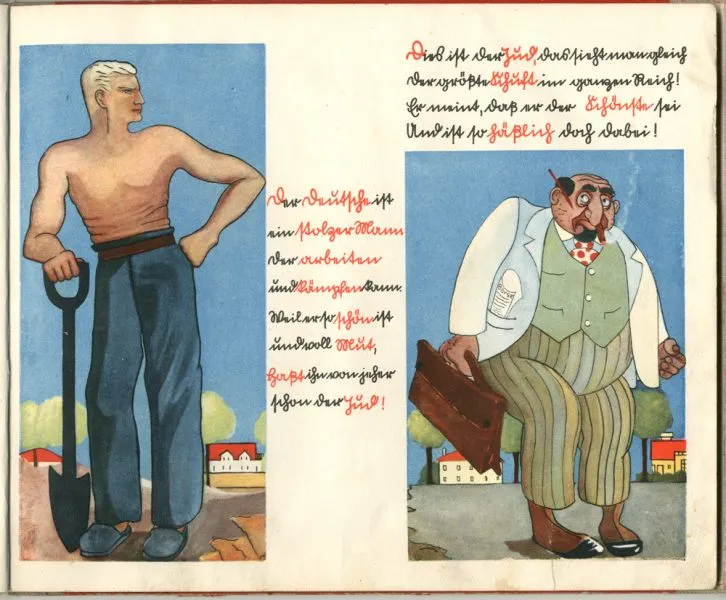
Tal como pueden ver, fue un trabajo minucioso que no pasó por alto ningún detalle, de forma que se aseguraron de ir moldeando las mentes de los pequeños alemanes para que ya crecieran con odio.
As you can see, it was painstaking work that didn't overlook any details, so they made sure to mold the minds of the little Germans so that they were already growing up with hatred.
Posteriormente, los nazis comenzaron a censar a los judíos para contabilizarlos, y les ordenaron identificar sus negocios con carteles en las vidrieras «Negocio Judío»
Later, the Nazis began to census the Jews to count them and ordered them to identify their businesses with posters in the windows "Jewish Business"
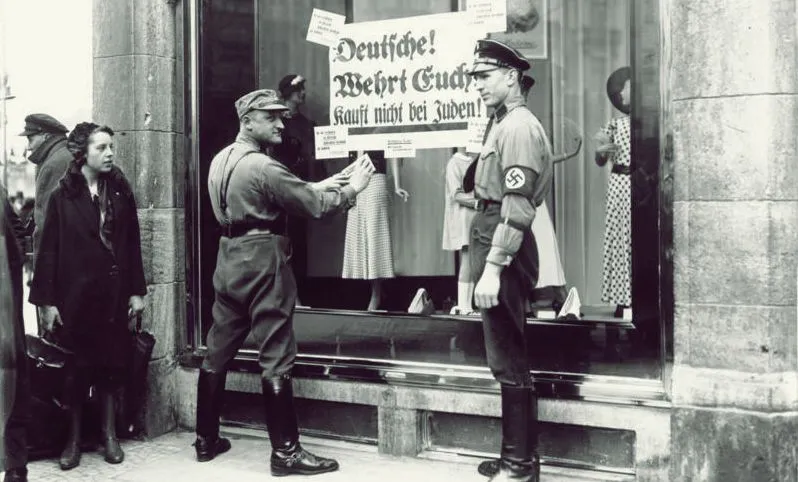
En 1935, los miembros de las S.A (SturmAbteilung, una organización paramilitar del partido nazi) se paseaban por las calles llevando carteles que decían «Alemanes! ¡Defiéndanse! ¡No les compren a los judíos!»
in 1935, members of the S.A (SturmAbteilung, a paramilitary organization of the Nazi party) walked the streets carrying signs that read 'Germans! Defend yourselves! Don't buy from the Jews!"
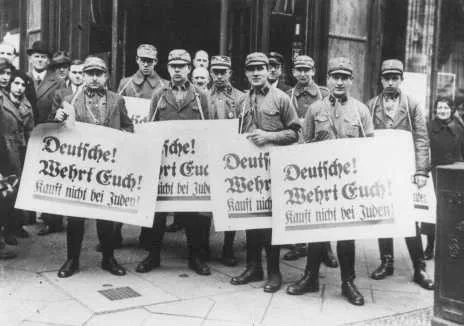
La Noche de los Cristales Rotos
The Night of the Broken Glass
Pero el 7 de noviembre de 1938, el secretario de la embajada de Alemania en Francia, Ernst Vom Rath, fue asesinado por un joven Judío polaco de origen alemán, Herschel Grynszpan. Los nazis entonces aprovecharon la ocasión para llevar a cabo el progromo que encendería la mecha que desató la furia de los antisemitas pues, miembros de las SS, de la SA y la Gestapo, vestidos de cívil, comenzaron a atacar los negocios identificados como judíos, arrojando piedras, saqueándolos y quemando todo lo que veían a su alrededor. Desde luego, esto alentó a la población alemana que se había dejado llevar por el odio previamente inculcado, y constantemente promovido por el Nacionalsocialismo.
But on November 7, 1938, the secretary of the German embassy in France, Ernst Vom Rath, was assassinated by a young Polish Jew of German origin, Herschel Grynszpan. The Nazis then took the opportunity to carry out the progrom that would light the fuse that unleashed the fury of the anti-Semites because members of the SS, the SA and the Gestapo, dressed in civilian clothes, began to attack businesses identified as Jews, throwing stones, looting them and burning everything they saw around them. Of course, this encouraged the German population that had been carried away by previously instilled hatred, and constantly promoted by National Socialism.
Este terrible acontecimiento fue conocido como «La Noche de los Cristales Rotos» o «Kristallnacht» en alemán, debido a los cristales de las vidrieras de los negocios judíos, que quedaron esparcidos por las calles. También quemaron sinagogas, lincharon personas, y otras tantas fueron capturadas y deportadas a los primeros campos de concentración.
This terrible event was known as "The Night of Broken Glass" or "Kristallnacht" in German, due to the stained glass windows of Jewish businesses, which were scattered throughout the streets. They also burned synagogues, lynched people, and many others were captured and deported to the first concentration camps.

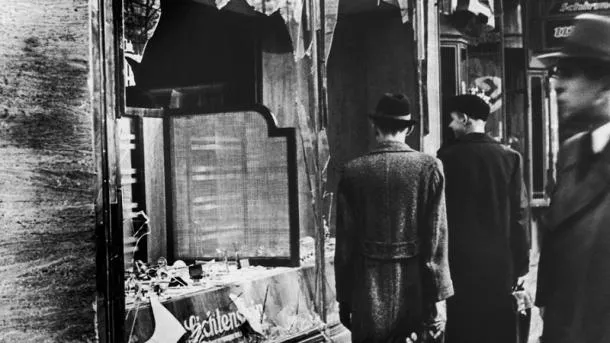
Hasta el día de hoy se sostiene que el asesinato de Vom Rath pudo haber sido organizado por los propios nazis, que enviaron a los miembros de las Juventudes Hitlerianas, las SS y las SA, apoyadas por la Gestapo, para desatar todo el desastre que vendría después.
To this day it's argued that the murder of Vom Rath may have been organized by the Nazis who sent members of the Hitler Youth, the SS and the SA, supported by the Gestapo, to unleash all the disaster that would follow.
Otras medidas drásticas
Other drastic measures
En 1939, los nazis ordenaron a los judíos llevar la insignia, que consistía en un brazalete blanco con una estrella de David azul bordada, la cual, debían llevar en el brazo derecho, con el objetivo de poder identificarlos de forma inmediata, y de esta manera se les prohibía entrar a cines, clubes e incluso escuelas. Por todas partes había lugares reservados a los judíos: banquetas en los parques, bebederos de agua en las plazas y hasta escuelas.
In 1939, the Nazis ordered the Jews to wear the insignia, which consisted of a white bracelet with an embroidered blue Star of David, which they had to wear on the right arm, in order to be able to identify them immediately, and thus They were forbidden to enter cinemas, clubs and even schools. Everywhere there were places reserved for Jews: sidewalks in parks, drinking fountains in squares, and even schools.
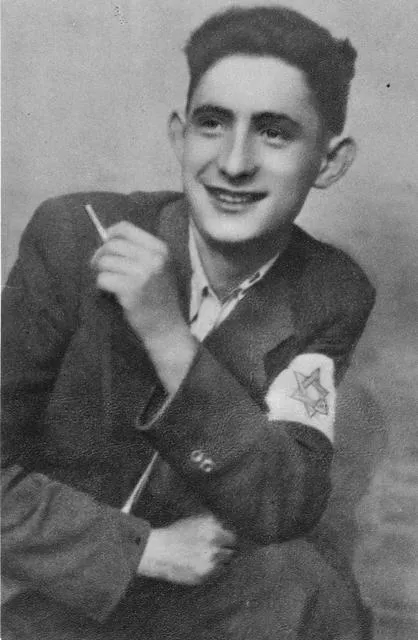
En esta fotografía vemos a una mujer vendiendo los brazaletes en las calles.
In this photograph we see a woman selling the bracelets on the streets.
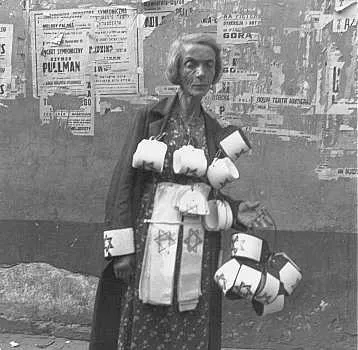
Para colmo, el primero de septiembre de 1939, Alemania invadió Polonia, violando el tratado de Versalles y el casi recién firmado acuerdo Ribbentrop - Molotov, desatando así, la segunda guerra mundial. Las cosas se pusieron feas para todos, pero para los judíos, todavía más.
To top it off, on September 1, 1939, Germany invaded Poland, violating the Versailles treaty and the almost recently signed Ribbentrop - Molotov agreement, thus unleashing World War II. Things got ugly for everyone, but for the Jews, even more so.
Se les negaba la compra de alimentos, medicinas o cualquier cosa que necesitaran, podían ser agredidos por cualquier persona sin recibir justicia, y para colmo, tenían que rendir cuentas de sus pertenencias al gobierno, pero no podían seguir regentando sus negocios, sino que alguien de origen ario debía ser el encargado de seguir manejándolo.
They were denied the purchase of food, medicine or anything they needed, they could be attacked by anyone without receiving justice, and to top it off, they had to account for their belongings to the government, but they could not continue to run their businesses, but someone of Aryan origin should be in charge of continuing to manage them.
Entonces, el 16 de octubre de 1941, empezaron las deportaciones de los judíos alemanes hacia los campos de concentración y gettos. Muchos lograron huir, pero otros no lo lograron.
Then, on October 16, 1941, the deportations of German Jews to the concentration camps and gettos began. Many managed to flee, but others did not.
El primero de septiembre de 1941, el brazalete que debían llevar los judíos, se sustituyó por la estrella de David amarilla, o «Maguen David». Reinhard Heydrich (Obergruppenführer, es decir, un alto rango de las SS) ordenó que todo judío mayor de seis años debía portarla.
On September 1, 1941, the bracelet that Jews were to wear was replaced by the yellow Star of David, or "Magen David." Reinhard Heydrich (Obergruppenführer, that is, a high rank in the SS) ordered that every Jew over the age of six must wear it.
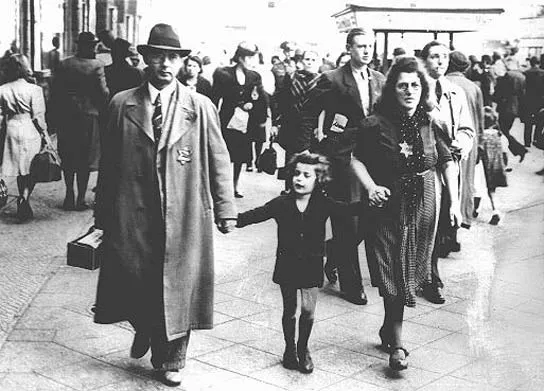
En los países ocupados por Alemania, a los judíos no les fue mejor, ellos tuvieron que esconderse o buscar refugio muy lejos, como lo fue el caso de Anna Frank y su familia, obligados a permanecer en un anexo secreto en Amsterdam, Holanda, hasta que finalmente fueron delatados y enviados a campos de concentración.
In the countries occupied by Germany, the Jews didn't do better, they had to hide or seek refuge far away, as was the case of Anne Frank and her family, forced to stay in a secret annex in Amsterdam, Holland, until that they were finally betrayed and sent to concentration camps.
La comida escaseaba, los recursos se acababan a causa de la guerra, pero los nazis se volvieron implacables en la cacería de judíos, los buscaban por las calles, irrumpían en las casas y los sacaban en medio de golpes y patadas, para obligarlos a subir a camiones que los llevarían a lugares horribles.
Food was scarce, resources were running out because of the war, but the Nazis became relentless in hunting down Jews, looking for them in the streets, breaking into houses and kicking them out, to force them up. to trucks that would take them to horrible places.

Generalmente, disfrutaban de cortar las barbas de los judíos ortodoxos para humillarlos, y además, porque sabían que, según su religión, un hombre debía permanecer con su barba larga y también el cabello en la zona de las sienes.
Generally, they enjoyed cutting off the beards of the Orthodox Jews to humiliate them, and furthermore, because they knew that according to their religion, a man should remain with his long beard and also the hair in the area of the temples.
En este caso, un grupo de ciudadanos polacos y soldados nazis obligaron a estos hombres a cortarse la barba entre sí
In this case, a group of Polish citizens and Nazi soldiers forced these men to cut each other's beards.
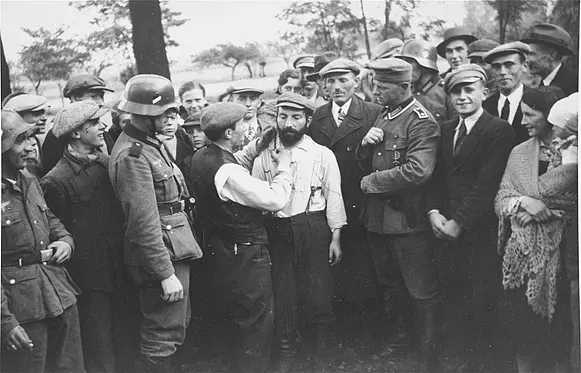
La vida dentro de los guettos y campos de concentración fue tan absurdamente horrible y llena de detalles, que da para escribir otro artículo para hablar únicamente de eso, pero basta con decirles que nadie habría querido ser enviado allí.
Life inside the ghettos and concentration camps was so absurdly horrible and full of details, that it gives to write another article to talk only about that, but suffice it to say that no one would have wanted to be sent there.
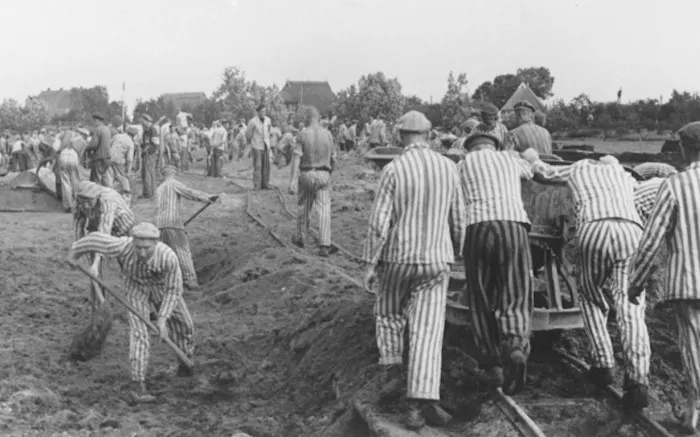
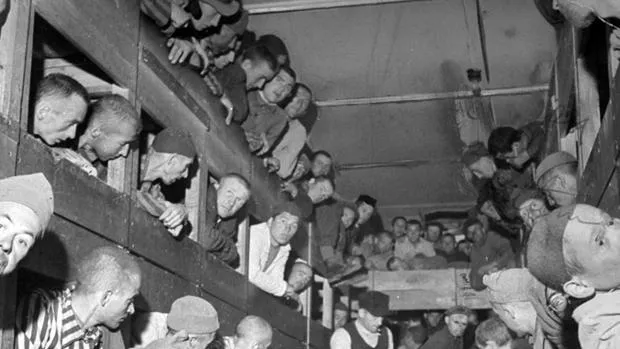
La solución final
The final solution
«La solución final» es el eufemismo con el que los nazis llamaron al exterminio masivo de los judíos, ya que empezaron a habilitar campos de exterminio, diseñados para acabar con la vida de miles de personas de una forma más rápida y eficiente.
"The final solution" is the euphemism with which the Nazis called the mass extermination of the Jews, since they began to set up extermination camps, designed to end the lives of thousands of people in a faster and more efficient way.
Estos campos contaban con cámaras diseñadas especialmente para que parecieran baños con duchas, y de esta forma poder engañar a las personas, que entraban allí sin oponer resistencia (algo que le evitaba a los guardias el uso de la fuerza y sus preciadas balas) Una vez dentro (según el campo de exterminio) los nazis cerraban la puerta y desde una escotilla ubicada en el techo, arrojaban monóxido de carbono o Zyclon B (una sustancia en forma de bolitas, que al contacto con la humedad se volvía un gas terriblemente tóxico)
These fields had cameras specially designed to look like bathrooms with showers, and in this way to be able to deceive people, who entered there without resisting (something that prevented the guards from using force and their precious bullets) Once inside (according to the extermination camp) the Nazis closed the door and from a hatch located in the roof, they threw carbon monoxide or Zyclon B (a substance in the form of balls, which in contact with humidity became a terribly toxic gas)
En esta fotografía, tomada en una de las cámaras de gas en el campo de exterminio Auschwitz - Birkenau, ubicado en Polonia, podemos ver las marcas de uñas que dejaron las víctimas en las paredes, en su desesperación por salir.
In this photograph, taken in one of the gas chambers at the Auschwitz - Birkenau extermination camp, located in Poland, we can see the fingernail marks left by the victims on the walls, in their desperation to get out.
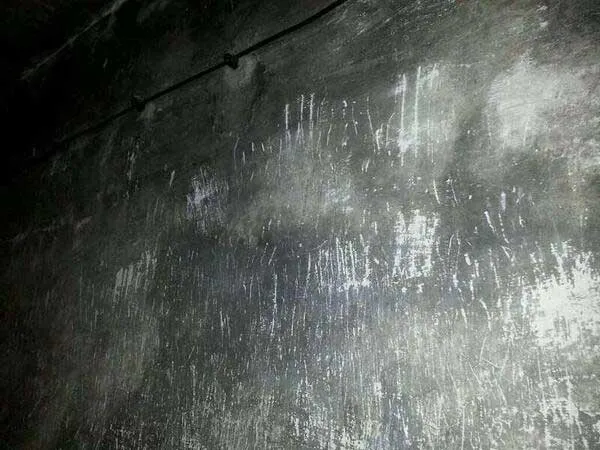
Y contiguo a estas cámaras estaban los hornos crematorios, donde reducían los cuerpos de las víctimas a cenizas.
And adjacent to these chambers were the crematorium ovens, where the bodies of the victims were reduced to ashes.


Pero no solo los judíos cayeron en manos de los nazis, también hubo cristianos católicos, cristianos evangélicos, testigos de Jehová, gitanos, musulmanes, homosexuales, personas con discapacidad, comunistas, y otras personas que ellos consideraban que eran inferiores o que simplemente se oponían a su ideología.
But not only the Jews fell into the hands of the Nazis, there were also Catholic Christians, Evangelical Christians, Jehovah's Witnesses, Gypsies, Muslims, homosexuals, people with disabilities, Communists, and others who they considered to be inferior or who simply opposed. to their ideology.
El holocausto dejó muchas víctimas, entre todas las etnias hubo más de 11 millones de personas asesinadas, pero de esa cantidad, nada más y nada menos 6 millones eran judíos.
The holocaust left many victims, among all ethnic groups there were more than 11 million people killed, but of that number, no more and no less 6 million were Jews.

Como han podido constatar, amigos, resulta escandaloso y terrible, comprobar hasta donde puede llegar el odio cuando es inculcado y promovido con tanta vehemencia: familias divididas, destruidas, pertenencias robadas, muerte y demás calamidades que no condujeron a ningún camino más que al dolor.
As you have seen, friends, it's scandalous and terrible, to see how far hatred can go when it's instilled and promoted with such vehemence: families divided, destroyed, belongings stolen, death and other calamities that didn't lead to any path other than pain.
Sin embargo, la generación actual tiene mucho que aprender del pasado, y sobre todo es importante conocer la historia para poder entenderla y jamás repetir las malas acciones que causaron tanto daño.
However, the current generation has much to learn from the past, and above all it's important to know history in order to understand it and never repeat the bad actions that caused so much damage.
Esto ha sido todo por hoy, amigos, espero que les haya gustado, nos vemos en una próxima oportunidad. Muchísimas gracias por decidir leer este post, gracias por tu apoyo.
This has been all for today, friends, I hope you liked it, see you next time. Thank you very much for deciding to read this post, thank you for your support.
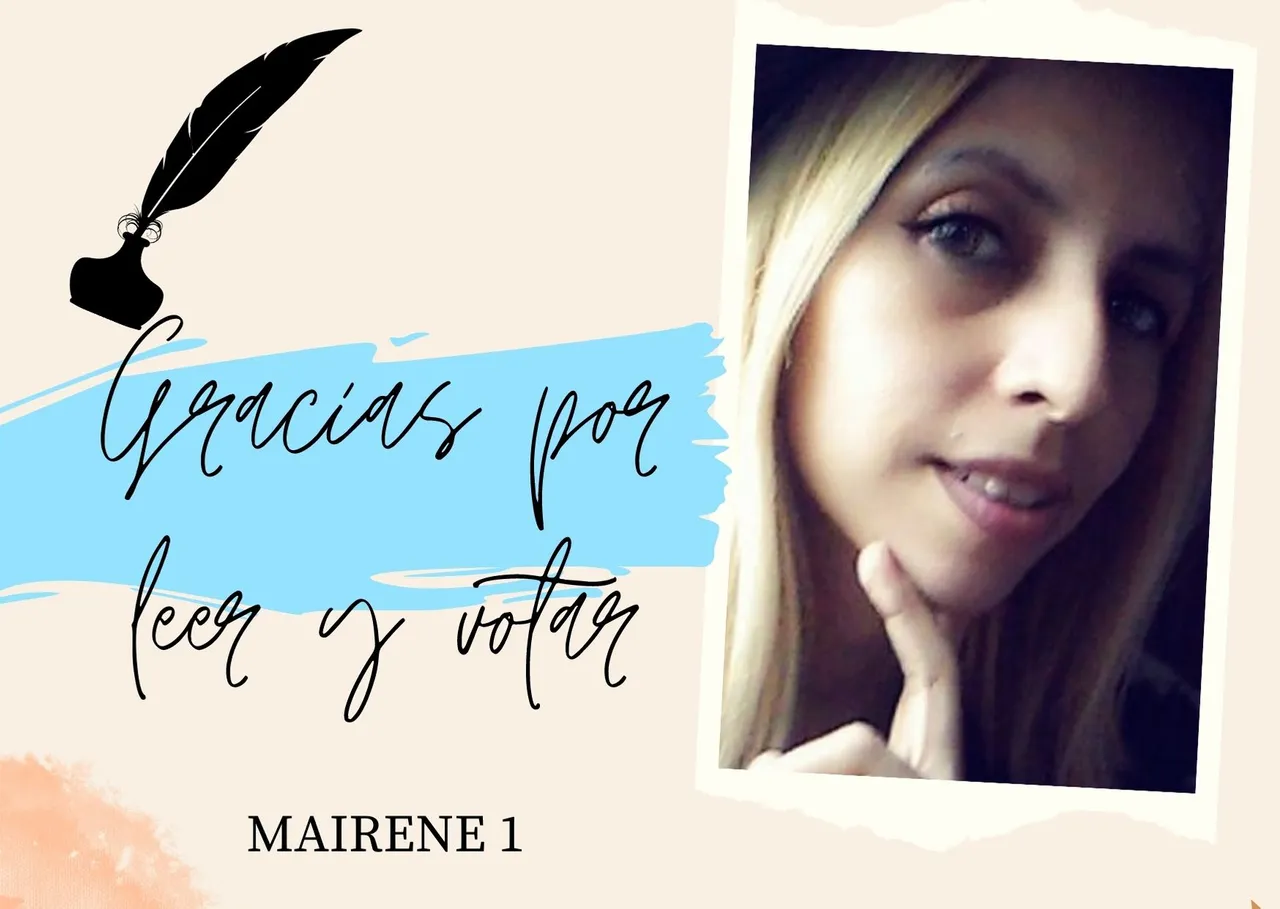
Thaks for reading and vote!
La portada, el separador de texto usado en este post y la imagen final de despedida, fueron diseñadas por mí, con el editor de canva
The cover, the text separator used in this post and the final farewell image, were designed by me, with the canva editor
